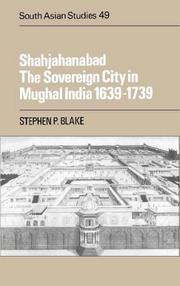| Listing 1 - 3 of 3 |
Sort by
|
Book
Year: 1986 Publisher: New Delhi Munshiram Manoharlal
Abstract | Keywords | Export | Availability | Bookmark
 Loading...
Loading...Choose an application
- Reference Manager
- EndNote
- RefWorks (Direct export to RefWorks)

ISBN: 0521390451 0521522994 0511563221 Year: 1990 Publisher: Cambridge : Cambridge University Press,
Abstract | Keywords | Export | Availability | Bookmark
 Loading...
Loading...Choose an application
- Reference Manager
- EndNote
- RefWorks (Direct export to RefWorks)
From 1400 to 1750, Asian capital cities were often ruled in such a way that they became symbols of the power and influence their emperors extended over their states at large. These 'sovereign cities' became the empire in miniature. Shahjahanabad is the first study of a pre-modern Indian city (Old Delhi) as a sovereign city. Stephen Blake explores the way in which the emperors' and nobles' palaces and mansions dominated the landscape; how cultural life revolved around that of the emperors and their families; and how the households of the great men also dominated the urban economy and controlled a large percentage of state revenue. This study thus illuminates how Asian capitals were not the great amorphous agglomerations described by Marx and Weber. Instead they were urban communities with their own distinctive style and character, dependent on a particular kind of state organization.
Delhi (India) --- History --- Mogul Empire --- Urbanization --- India --- Delhi (India) - History. --- Mogul Empire - History. --- Urbanization - India - History. --- Arts and Humanities --- History. --- Cities and towns, Movement to --- Urban development --- Urban systems --- Cities and towns --- Social history --- Sociology, Rural --- Sociology, Urban --- Urban policy --- Rural-urban migration --- Mughal Empire
Book
ISBN: 8132224302 8132224310 Year: 2016 Publisher: New Delhi : Springer India : Imprint: Springer,
Abstract | Keywords | Export | Availability | Bookmark
 Loading...
Loading...Choose an application
- Reference Manager
- EndNote
- RefWorks (Direct export to RefWorks)
Middle India and Rural-Urban Development explores the socio-economic conditions of an ‘India’ that falls between the cracks of macro-economic analysis, sectoral research and micro-level ethnography. Its focus, the ‘middle India’ of small towns, is relatively unknown in scholarly terms for good reason: it requires sustained and difficult field research. But it is where most Indians either live or constantly visit in order to buy and sell, arrange marriages and plot politics. Anyone who wants to understand India therefore needs to understand non-metropolitan, provincial, small-town India and its economic life. This book meets this need. From 1973 to the present, Barbara Harriss-White has watched India’s development through the lens of an ordinary town in northern Tamil Nadu, Arni. This book provides a pluralist, multi-disciplinary and inter-disciplinary perspective on Arni and its rural hinterland. It grounds general economic processes in the social specificities of a given place and region. In the process, continuity is juxtaposed with abrupt change. A strong feature of the book is its analysis of how government policies that fail to take into account the realities of small town life in India have unintended and often perverse consequences. In this unique book, Harriss-White brings together ten essays written by herself and her research team on Arni and its surrounding rural areas. They track the changing nature of local business and the workforce; their urban-rural relations, their regulation through civil society organizations and social practices, their relations to the state and to India’s accelerating and dynamic growth. That most people live outside the metropolises holds for many other developing countries and makes this book, and the ideas and methods that frame it, highly relevant to a global development audience.
Rural development -- India -- History. --- Urbanization -- India -- History. --- Anthropology --- Social Sciences --- Anthropogeography & Human Ecology --- Urbanization --- Rural development --- History. --- Community development, Rural --- Development, Rural --- Integrated rural development --- Regional development --- Rehabilitation, Rural --- Rural community development --- Rural economic development --- Cities and towns, Movement to --- Urban development --- Urban systems --- Citizen participation --- Social aspects --- Agriculture and state --- Community development --- Economic development --- Regional planning --- Cities and towns --- Social history --- Sociology, Rural --- Sociology, Urban --- Urban policy --- Rural-urban migration --- Human Geography. --- Development economics. --- Development Economics. --- Urban Geography / Urbanism (inc. megacities, cities, towns). --- Economics --- Anthropo-geography --- Anthropogeography --- Geographical distribution of humans --- Social geography --- Geography --- Human ecology --- Human geography. --- Urban geography.
| Listing 1 - 3 of 3 |
Sort by
|

 Search
Search Feedback
Feedback About UniCat
About UniCat  Help
Help News
News